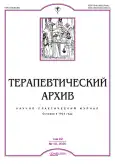Iodine deficiency disorders as a non-infectious epidemic: a look at the problem at the tome of COVID-19 pandemic
- 作者: Mel’nichenko G.A.1, Troshina E.A.1, Gerasimov G.A.2
-
隶属关系:
- National Medical Research Center for Endocrinology
- Iodine Global Network
- 期: 卷 92, 编号 10 (2020)
- 页面: 4-8
- 栏目: Editorial article
- URL: https://journals.rcsi.science/0040-3660/article/view/50962
- DOI: https://doi.org/10.26442/00403660.2020.10.000768
- ID: 50962
如何引用文章
全文:
详细
Radioactive iodine, flying out of the destroyed reactor of the Chernobyl nuclear power plant, like a corona virus quickly spread throughout Europe. Iodine deficiency in the regions of Ukraine, Belarus and Russia adjacent to nuclear power plants became a factor in increased uptake of radioactive iodine by the thyroid gland in children and after 5 years led to an epidemic of thyroid cancer. Optimal iodine intake could become a kind of «vaccination», which sharply reduces the risk of developing thyroid cancer, as has happened after the accident at the Fukushima nuclear power plant in Japan. Endemic goiter was eliminated 50 years ago, but returned to the country in the early 1990s after the collapse of iodized salt production and has not been eliminated to this day due to the lack of a legislative framework for mandatory salt iodization. The actual average consumption of iodine by residents of Russia is from 40 to 80 mcg per day, which is 2–3 times less than the recommended norm. Mild and moderate iodine deficiency was detected throughout the Russian Federation, and it is more typical for the the rural population. The iodine deficiency has the greatest negative effect on the psychomotor development of the child during the critical period – «the first 1000 days of life» – from the moment of conception to the end of the second year of life. According to WHO, over the past 20 years, iodine deficiency has been eliminated in 115 countries of the world, and the number of iodine-deficient countries has dropped to 25, but Russia is still among them. We believe that after the COVID-19 pandemic, it will no longer be necessary to prove the need for effective support for the prevention of both infectious and non-infectious diseases, and the declared preventive direction of Russian medicine will indeed become such.
作者简介
G. Mel’nichenko
National Medical Research Center for Endocrinology
Email: troshina@inbox.ru
ORCID iD: 0000-0002-5634-7877
акад. РАН, д.м.н., проф., зам. дир. ФГБУ «НМИЦ эндокринологии»
俄罗斯联邦, MoscowE. Troshina
National Medical Research Center for Endocrinology
编辑信件的主要联系方式.
Email: troshina@inbox.ru
ORCID iD: 0000-0002-8520-8702
чл.-кор. РАН, д.м.н., проф., зам. дир. ФГБУ «НМИЦ эндокринологии»
俄罗斯联邦, MoscowG. Gerasimov
Iodine Global Network
Email: troshina@inbox.ru
ORCID iD: 0000-0002-6299-7219
д.м.н., проф., региональный координатор МНО «Глобальная сеть по йоду»
美国, Myrtle Beach参考
- Figge J, Jennings T, Gerasimov G, et al. Radiation-Induced Thyroid Cancer. In: L. Wartofsky, D. Nostrand, Eds: Thyroid Cancer. A Comprehensive Guide to Clinical Management. Third Edition, Springer, 2016.
- Takamura N, Orita V, Saenko V, et al. Radiation and risk of thyroid cancer: Fukushima and Chernobyl. Lancet. Diabetes Endocrinol. 2016;4:647. doi: 10.1016/S2213-8587(16)30112-7
- Николаев О.В. Этиология эндемического зоба. М.: Медгиз, 1932 [Nikolaev OV. Etiology of Endemic Goiter. Moscow: Medgiz, 1932 (In Russ.)].
- Герасимов Г.А. Йододефицитные заболевания (ЙДЗ) в Российской Федерации: политика в области профилактики и тенденции в эпидемиологической ситуации (1950–2002 гг.). М., 2003 [Gerasimov GA. Iodine Deficiency Disorders (IDD) in the Russian Federation: A Review of Policies towards IDD Prevention and Control and Trends in IDD Epidemiology (1950–2002). Moscow, 2003 (In Russ.)].
- Volpe R. Autoimmune thyroiditis. In: Disease of the thyroid. Ed. LE. Braverman. Humana Press Inc., 1997.
- Герасимов Г.А., Мельниченко Г.А., Фадеев В.В. Мифы отечественной тиреоидологии и аутоиммунный тиреоидит. Consilium Medicum. 2001;11(3) [Gerasimov GA, Melnichenko GA, Fadeev VV. Myths of domestic thyroidology and autoimmune thyroiditis. Consilium Medicum. 2001;11(3) (In Russ.)].
- ЮНИСЕФ; Глобальная сеть по йоду. Рекомендации по мониторингу программ йодирования соли и оценке статуса йодной обеспеченности населения (русскоязычная версия). Клин. и экспериментальная тиреоидология. 2018;14(2):100-12 [UNICEF; IGN. Guidance on the monitoring of salt iodization programmes and determination of population iodine status: Russian language version. Clinical and experimental thyroidology. 2018;14(2):100-12 (In Russ.)]. doi: 10.14341/ket9734
- Cusick S, Georgieff M. The first 1,000 days of life: The brain’s window of opportunity. https://www.unicef-irc.org/article/958-the-first-1000-days-of-life-the-brains-window-of-opportunity.html
- Pearce E, Lazarus J, Moreno-Reyes R, Zimmermann M. Consequences of iodine deficiency and excess in pregnant women: an overview of current knowns and unknowns. Am J Clin Nutr. 2016;104:918S-923S. doi: 10.3945/ajcn.115.110429
- IGN Annual Report, 2019. https://www.ign.org/cm_data/ 2019_IGN_Annual_Report_051820.pdf
补充文件







